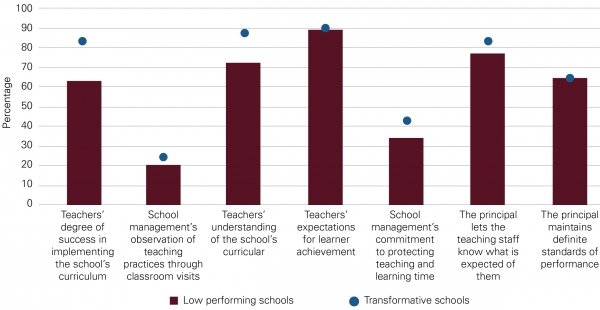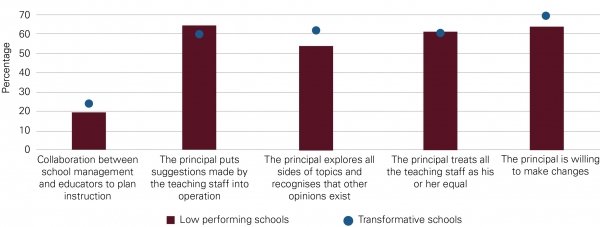How transformative principals can close the achievement gap in South African schools
South African schools face the challenge of equipping learners to thrive in a society already buckling under the weight of unemployment, inequality and poverty. Despite innovative policy changes in the education system, resource-constrained schools in South Africa (no-fee schools) continue to struggle to produce competitive academic results. A recent paper by the HSRC’s Andrea Juan and Sylvia Hannan shows that, while some factors of academic performance are linked to the availability of resources, transformative leaders attuned to the learning environment and committed to change can help to close the achievement gap. By Andrea Teagle

At the core of transformative leadership is the goal to achieve systemic change and social justice. To paraphrase Sharlene Swartz, who spoke at the HSRC’s March 2022 symposium on transformative leadership in African contexts, transformative leadership is about changing the odds to allow many to thrive, rather than empowering a few to succeed and beat the odds, despite systemic obstacles.
Keeping in mind this goal of bringing about change for more than just a few, what role can transformative leaders play? At the symposium, which brought together scholars and young leaders from across the African continent, the HSRC’s Andrea Juan and Sylvia Hannan presented an analysis of data that focused on how change happens in resource-constrained schools.
The researchers used South African data from the 2019 Trends in International Mathematics and Science Study (TIMSS), an international assessment that measures educational performance of Grade 4 or 5 and Grade 8 or 9 learners and helps countries to monitor their education systems over time. Focusing on the Grade 5 data, they grouped fee-paying and no-fee-paying schools to approximate well-resourced and resource-constrained schools, respectively. In South Africa, schools’ achievement scores in mathematics and other subjects are largely clustered at opposite ends of the performance spectrum. No-fee-paying schools, located in poor communities and operating in resource-constrained contexts, generally have low achievement scores – although some exceptions do exist.
Juan and Hannan found that 17% of the no-fee-paying primary schools produced above-average mathematics achievement scores – with average scores above the national average. These unexpected higher scorers they dubbed ‘transformative schools’.
Despite operating in resource-constrained settings, these schools had managed to empower many learners to thrive. How had they changed the odds of academic success for their learners?

Articulating a common vision
The HSRC duo hypothesised that the way school principals ran their schools would explain some of the variations in no-fee schools’ performance. Some factors, of course, are beyond the control of principals. These include limited school resources, larger class sizes and the home environment of learners. But some factors, such as the quality of teaching and the creation of a safe and orderly environment, could be influenced by transformative leadership practices.
Speaking at the symposium, Juan argued that quality of leadership was particularly important in resource-constrained schools. Previous literature has indicated that the ability of a principal to create a shared vision was central to building effective, equitable and inclusive institutions, she said. A leader’s shared vision could influence (1) whether the school environment is conducive to learning and teaching; (2) to what degree there is a focus on achievement and excellence; and 3) whether there is collaboration between school stakeholders, including principals, teachers, parents and learners.
In total, Hannan and Juan explored 20 variables conceptually related to transformative leadership that fall into the above three categories, comparing the achievement scores of ‘transformative’ no-fee schools with other no-fee-paying schools (Figures 1 to 3). The scores are based on responses to the TIMSS contextual questionnaires by school principals, teachers and learners.

“When we looked at [transformative] schools, they generally showed higher scores on 20 indicators which we have clustered into three groups related to a conducive learning and teaching environment, academic achievement, and collaboration – all of which we believe depend on transformative leadership,” Hannan said.
The widest gaps between transformative no-fee-paying schools and the rest were in the ‘conducive learning and teaching environment’ category. In transformative schools, learners were more likely to report a sense of belonging, to respect their classmates and to experience less bullying. More learners in these schools reported wanting to perform well and had a positive attitude towards maths. Teachers were more likely to inspire learners and to report higher job satisfaction. (Figure 1).
Although the degree to which leadership was responsible for the higher scores in these schools was not ascertainable from the data, Juan and Hannan referred to previous research that suggests that principals play a key role in promoting inclusive and respectful learning environments.
This makes intuitive sense: teachers who are supported and who are encouraged to collaborate are better equipped to inspire learners. Principals can also implement strategies to support struggling learners and to address bullying and poor discipline – although some potential measures might be limited by lack of resources.
A focus on academic excellence
Gaps also emerged in the achievement scores of transformative and non-transformative no-fee schools in the ‘focus on academic achievement’ category (Figure 2 ).

The data indicated that in the higher-achieving schools, teachers were more likely to succeed in implementing the curriculum and were more likely to understand the curriculum. Again, how much of this variation is due to leadership is not ascertainable from the data. However, the authors refer to other research that found that principals who “developed strategies and activities that aligned with the school’s mission, and placed emphasis on academic success, were more effective in leading their staff and experienced greater improvement in learner outcomes”.
Collaboration
Finally, the analysis found that collaboration may have had some positive impact on the achievement of transformative schools (Figure 3 ).

Three of the five indicators were higher in these schools, with more teachers reporting that principals explored all sides of a topic, recognised different opinions, and that they were willing to make changes.
The authors concluded that no-fee schools that achieved above the national average in TIMSS display many of the characteristics that can be influenced by effective leadership. “Transformative leadership in schools is not an abstract notion,” Juan argued. “Nor does it require Herculean efforts, but it can be obtained using specific practices with system-changing outcomes.”
Schools are thus an important setting for transformative leadership, because of the potential for inter-generational multiplier effects – empowered learners can become transformative leaders, helping to build a more equitable future for South Africa.
For a full description of the TIMSS methodology and data, please see: Reddy, V., Winnaar, L., Harvey, J., Hannan, S., Isdale, K., Arends, F. & Juan, A. (2022). The South African TIMSS 2019 Grade 5 Results: Building Achievement and Bridging Achievement Gaps. HSRC Press, Cape Town.
Researchers:
Andrea Juan, a senior research specialist, and Sylvia Hannan, a senior researcher, in the HSRC’s Inclusive Economic Development research division
Author:
Andrea Teagle, science writer in the HSRC’s Impact Centre




